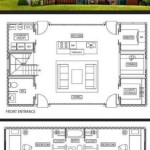Understanding Simple 2D House Plans with Dimensions
Creating a house plan, whether for a new build or a renovation, starts with understanding the basics. A 2D house plan serves as a fundamental visual representation of the layout, and including dimensions is critical for accurate construction and space planning. This article will explore the essential aspects of simple 2D house plans with dimensions, providing insights into their creation, interpretation, and practical application.
A 2D house plan is a scaled diagram showing the arrangement of rooms, walls, doors, windows, and other structural elements on a single plane. This overhead view provides a clear picture of the floor layout, enabling architects, builders, and homeowners to visualize the space and plan accordingly. Unlike 3D renderings, which offer a more realistic perspective, 2D plans focus on accuracy and functionality, providing precise measurements and spatial relationships.
The addition of dimensions to a 2D house plan elevates its usefulness significantly. Dimensions indicate the length, width, and height of various elements, ensuring that the construction process adheres to the intended design. These measurements are indispensable for ordering materials, accurate cost estimations, and precise execution of the building plan.
Key Elements of a 2D House Plan with Dimensions
Several key elements contribute to the clarity and accuracy of a 2D house plan with dimensions. These include walls, doors, windows, room labels, and precise measurements. Understanding how these elements are represented and interpreted is crucial for effectively using the plan.
Walls are typically represented as solid, thick lines, indicating the boundaries of rooms and the exterior structure of the house. Interior walls might be depicted with thinner lines compared to load-bearing walls. The dimensions associated with walls include their thickness and length. These measurements are crucial for calculating the total wall area, which is necessary for material estimations like drywall, paint, and insulation.
Doors are usually represented as an arc showing their swing direction and a straight line indicating the door frame. The dimensions provided for doors include the width of the door opening and the height of the door itself. These measurements are essential for selecting appropriate door sizes and for ensuring that doors fit within the allocated space. The swing direction is also important to consider to avoid interference with furniture or other fixtures.
Windows are typically represented as two or three parallel lines within the wall outline. The dimensions associated with windows include the width and height of the window opening, as well as their sill height (the distance from the floor to the bottom of the window). Accurate window dimensions are critical for ordering windows of the correct size and for ensuring proper alignment during installation. Window placement is also important for maximizing natural light and ventilation in the room.
Room labels are essential for identifying the purpose of each space within the house. These labels help clarify the layout and facilitate communication between different stakeholders involved in the project. Dimensions associated with rooms include their length, width, and often, their height (although height is more commonly found in elevation drawings). These room dimensions are important for determining the size of furniture that will fit comfortably within the space and for planning the overall functionality of the room.
Precise measurements are perhaps the most crucial aspect of a 2D house plan with dimensions. These measurements should be clearly labeled and accurate. Common units of measurement include feet and inches (in the United States) or meters and centimeters (in metric countries). Accurate dimensions are vital for ensuring that the constructed building matches the intended design and for avoiding costly errors during the building process. It is also crucial to include overall dimensions for the house, showing the total width and length of the structure.
Interpreting Dimensions on a 2D House Plan
Understanding how dimensions are presented on a 2D house plan is essential for accurately interpreting the information. Dimensions are typically presented as linear measurements, indicated by lines with arrowheads at both ends, pointing to the points being measured. The measurement value is usually placed above or beside the dimension line.
Different types of dimensions are used to convey specific information. Overall dimensions show the total length and width of the house, while interior dimensions show the size of individual rooms. Wall dimensions indicate the thickness and length of walls. It's important to distinguish between these different types of dimensions to avoid confusion.
Architects and designers often use different dimensioning techniques to ensure clarity. For example, chain dimensioning involves a series of connected dimension lines showing the cumulative length of multiple segments. Baseline dimensioning involves referencing all measurements from a single baseline, which helps maintain accuracy and consistency. Understanding these techniques can aid in interpreting the plan accurately.
Furthermore, it is important to pay attention to the unit of measurement used on the plan. Most plans specify the unit of measurement (e.g., feet and inches, meters, millimeters) in a note or legend. Failing to recognize the unit of measurement can lead to significant errors in construction and space planning.
Accuracy is paramount when interpreting dimensions on a 2D house plan. Even small errors can accumulate and lead to significant discrepancies during the building process. It is advisable to double-check all measurements and consult with the architect or designer if any discrepancies are suspected. Additionally, understand the difference between nominal and actual dimensions. Nominal dimensions are the stated or “named” dimensions, while actual dimensions are the precise measurements of the materials after manufacturing. This is most relevant when dealing with lumber and other building materials.
Practical Applications of Simple 2D House Plans with Dimensions
Simple 2D house plans with dimensions have a wide range of practical applications, from initial design and planning to construction and renovation. They serve as a blueprint for the entire project, guiding the efforts of architects, builders, contractors, and homeowners.
During the initial design phase, a 2D house plan with dimensions helps visualize the layout and spatial relationships within the house. It allows architects and homeowners to experiment with different configurations, rearrange rooms, and optimize the use of space. The dimensions provide a concrete basis for evaluating the feasibility of different design options and making informed decisions.
For builders and contractors, the 2D house plan with dimensions is a critical tool for accurate construction. It provides precise measurements for laying out walls, installing doors and windows, and constructing other structural elements. The dimensions also facilitate accurate material estimations, allowing contractors to order the correct amount of materials and avoid costly waste. Builders rely heavily on the accuracy of these dimensions to ensure that the building is constructed according to the intended design.
During the construction process, the 2D house plan with dimensions serves as a reference point for all trades involved in the project, including plumbers, electricians, and HVAC installers. It helps them understand the layout of the house and the location of key elements, such as pipes, wiring, and ventilation ducts. Accurate dimensions are crucial for ensuring that these elements are installed correctly and that they do not interfere with other structural components.
For homeowners, a 2D house plan with dimensions can be invaluable for space planning and interior design. It allows them to visualize how furniture will fit within the rooms and to plan the layout of their living spaces. The dimensions provide a basis for selecting furniture sizes and for ensuring that furniture is appropriately scaled for the room. It can also be used for planning the placement of lighting fixtures, artwork, and other decorative items.
In renovation projects, a 2D house plan with dimensions can be used to accurately assess the existing structure and plan for modifications. It helps identify load-bearing walls, the location of utilities, and other critical features. The dimensions can be used to create accurate drawings of the existing space and to develop plans for the renovation. This is particularly important for projects involving structural alterations or additions.
In conclusion, a simple 2D house plan with dimensions is an essential tool for any construction or renovation project. Understanding the key elements, interpreting dimensions accurately, and appreciating the practical applications are crucial for successful execution. This plan provides a common language and a shared visual representation for all stakeholders involved, ensuring that the project stays on track and meets the intended objectives.

Draw 2d Floor Plans In Minutes Not Hours Cedreo

12 Examples Of Floor Plans With Dimensions

2d Floor Plan Archives Page 2 Of 6 Dk Home Designx

Beautiful 2d Floor Plan Ideas Engineering Discoveries Home Map Design Building House Plans Designs

Create Professional 2d Floor Plans Roomsketcher

2d Floor Plans Plan Design Home Small Kitchen

30 Fantastic 2d Floor Plan Ideas Engineering Discoveries Simple House Plans 30x50 Little

2d Floor Plan Archives Page 2 Of 6 Dk Home Designx

Beautiful 2d Floor Plan Ideas Engineering Discoveries Building House Plans Designs Simple Small

2d Plan Of The Existing First Floor Building All Dimensions Are In M Scientific Diagram
Related Posts








